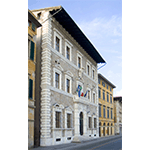Universitą degli Studi di Pisa - Rettorato [University of Pisa - Rectorate]
The "Studium Generale" of Pisa was officially instituted in 1343 by a papal bull "In supremae dignitatis" issued by Pope Clement VI. This provision established at the Pisan institution the faculties of Theology, Canon and Civil Law, and Medicine, leaving open the possibility of instituting further courses. Some sixty years later, with the annexation of Pisa to the government of Florence, the activity of the "Studio" came to an end, to return to life only under Lorenzo the Magnificent in 1473. In the late 15th and early 16th century, the "Studio" was moved to other seats, such as Pistoia and Prato. Due to Pisa's rebellion against Florentine domination, it was then moved to Florence, to return to its original seat in 1515. Under Cosimo I it was reorganised to become a major European centres of research and scientific teaching. With the solemn reopening of 1543 the "Studio" was given new statutes that made it competitive with the other Italian and European universities. Along with protectionist measures such as the provisions that obliged Florentine students to graduate from the university of their own State, provisions were issued for upgrading teaching and research in the scientific sector, thus making the Studio an "international" institution. Among the illustrious scientists who taught at the University were Andrea Vesalio (Anatomy), Luca Ghini (Herbal Medicines), Realdo Colombo (Anatomy), Gabriele Falloppia (Anatomy), Andrea Cesalpino (Herbal Medicines and Practical Medicine), Galileo Galilei (Mathematics), Girolamo Mercuriale (Practical Medicine), Giovanni Battista Ruschi (Anatomy), Benedetto Castelli (Mathematics), Giovanni Alfonso Borelli (Mathematics), Marcello Malpighi (Theoretical Medicine), Lorenzo Bellini (Anatomy), and Antonio Cocchi (Theoretical Medicine).
In the second half of the 18th century the Lorraine Grand Dukes conferred new life on the institution by donating to it an astronomical observatory and instituting new chairs of science, such as that of chemistry (1757), assigned to Nicola Branchi, and that of experimental physics. It was in those same years that the teaching of surgery developed rapidly, thanks to the work of Francesco Vaccą Berlinghieri.
During the Napoleonic period, the Studio was transformed into the Imperial Academy, dependent on the University of Paris, and made responsible for supervising the entire Tuscan school system.
With the Restoration, the Studio became independent again when, at the initiative of Cosimo Ridolfi, the Institute of Agriculture was created, the first Chair of Veterinary Science was instituted and the publication of numerous scientific reviews was begun. Eminent scientists taught at Pisa from the second half of the 19th century through the beginning of the 20th. Among them were Giovan Battista Amici, Enrico Betti, Ulisse Dini, Antonio Pacinotti and Luigi Bianchi. In 1839 it was the seat of the first Congress of Italian Scientists.
The University of Pisa conserves, in the seventeenth-century Palazzo Lanfreducci, known as "Alla giornata", seat of the Rectorate, a small but significant collection of scientific instruments, including four important seventeenth-century globes, celestial and terrestrial, the work of Willem Jansz Blaeu, and an interesting dial barometer from the middle of the 18th century.
****************************
Texts by Anna Toscano
English translation by Catherine Frost
Last update 06/feb/2008




